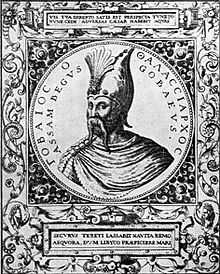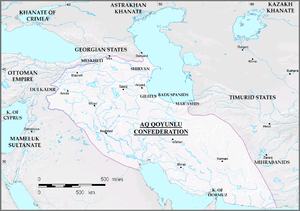Uzun Hassan
| Uzun Hassan | |
|---|---|
|
Bey Iranian King of Kings Iranian Sultan of Sultans Shahanshah of Iran and Ruler of Persia Powerful like Jamshid, flag of Fereydun and wise like Darius[1] Padishah of Iran[2] | |
 Uzun Hassan as depicted in this European illustration. | |
| Reign |
Amed: 1453 – 1471 Tabriz:1471 – January 6, 1478 |
| Full name | Uzun Hassan bin Ali bin Qara Yoluq Osman |
| Titles | Abul-Nasr |
| Born | 1423 |
| Died | 1478 |
| Predecessor |
Jahangir bin Ali Qilich Arslan bin Ahmed |
| Successor | Sultan Khalil bin Uzun Hasan |
| Consort | Despina Khatun |
| Issue |
Mirza Khalil Yaqub Maqsud Ughurlu Muhammad Yusuf Beg Masih Beg Halima Begum aka Martha Zaynalabidin Beg |
| Dynasty | Aq Qoyunlu dynasty |
| Father | Ali bin Qara Yoluq Osman |
| Mother | Sarai Khatun |
| |||||

Uzun Hasan or Hassan (1423 – January 6, 1478) (Azerbaijani: اوزون حسن , Uzun Həsən; Turkish: Uzun Hasan, where uzun means "tall"; Persian: اوزون حسن) was a sultan of the Aq Qoyunlu dynasty, also known as the White Sheep Turkmen. Hassan was ruler of (western) Iran which included also parts of present-day Iraq, Turkey, Azerbaijan and Armenia between 1453 and 1478.
Timur appointed his great-grandfather, Kara Yülük Osman, as a governor of Amed (Diyarbakır in modern-day Turkey), with the cities of Erzincan, Mardin, Roha (or Urfa), and Sivas. Later, Persia was divided between two Timurid rulers, Jahan Shah of Kara Koyunlu (the Black Sheep Turkmen) and Uzun Hasan. After twenty years of fighting, Uzun Hasan eventually defeated Jahan Shah in a battle near the sanjak of Çapakçur[3][4] in present day eastern Turkey on October 30[5] (or November 11[6]), 1467. Upon the defeat of the latter, another Timurid ruler, Abu Sa'id Mirza, answered Jahan Shah's son's request for aid, taking much of Jahan Shah's former land and going to war with Uzun Hasan despite the latter's offers of peace. Uzun Hasan then ambushed and captured Abu Sa'id at the Battle of Qarabagh, whereupon he was executed by Yadgar Muhammad Mirza, a rival.[7]
In 1463, the Venetian Senate, seeking allies in its war against the Ottomans, sent Lazzaro Querini as its first ambassador to Tabriz,[8] but he was unable to persuade Uzun Hassan to attack the Ottomans.[9] Hassan sent his own envoys to Venice in return.[8] In 1471, Querini returned to Venice with Hazzan's ambassador Murad.[8] The Venetian Senate voted to send another to Persia, choosing Caterino Zeno after two other men declined.[10] Zeno, whose wife was the niece of Uzun Hassan's wife, was able to persuade Hassan to attack the Turks. Hassan was successful at first, but there were no simultaneous attack by any of the western powers.[9]
Uzun-Hassan met the Ottomans in battle near Erzincan in 1471 and at Tercan in 1473. He was defeated by Mehmed II at Battle of Otlukbeli in the late summer of 1473.[11]
In 1473, Giosafat Barbaro was selected as another Venetian ambassador to Persia, due to his experience in the Crimean, Muscovy, and Tartary.[12] Although Barbaro got on well with Uzun Hassan, he was unable to persuade the ruler to attack the Ottomans again.[9] Shortly afterwards, Hassan's son Ogurlu Mohamed, rose in rebellion, seizing the city of Shiraz.[13]
After yet another Venetian ambassador, Ambrogio Contarini, arrived in Persia,[9] Uzun Hassan decided that Contarini would return to Venice with a report, while Giosafat Barbaro would stay.[14] Barbaro was the last Venetian ambassador to leave Persia, after Uzun Hassan died in 1478.[15][16] While Hassan's sons fought each other for the throne, Barbaro hired an Armenian guide and escaped.[17]
According to Contarini, ambassador to Uzun-Hassan's court from 1473 to 1476, "The king is of a good size, with a thin visage and agreeable countenance, and seemed to be about seventy years old. His manners were very affable, and he conversed familiarly with every one around him; but I noticed that his hands trembled when he raised the cup to his lips." His name means "tall" and Contarini reported that he was also "very lean".
Contarini also wrote, "The empire of Uzun-Hassan is very extensive, and is bounded by Turkey and Caramania, belonging to the Sultan, and which latter country extends to Aleppo. Uzun-Hassan took the kingdom of Persia from Causa, whom he put to death. The city of Ecbatana, or Tauris, is the usual residence of Uzun-Hassan; Persepolis or Shiras ...,[18] which is twenty-four days journey from thence, being the last city of his empire, bordering on the Zagathais, who are the sons of Buzech, sultan of the Tartars, and with whom he is continually at war. On the other side is the country of Media, which is under subjection to Sivansa, who pays a kind of yearly tribute to Uzun-Hassan. It is said that he has likewise some provinces on the other side of the Euphrates, in the neighbourhood of the Turks. The whole country, all the way to Ispahan... is exceedingly arid, having very few trees and little water, yet it is fertile in grain and other provisions.
"His eldest son, named Ogurlu Mohamed, was much spoken of when I was in Persia, as he had rebelled against his father. He had other three sons; Khalil Mirza, the elder of these was about thirty-five years old, and had the government of Shiras. Jacub beg, another son of Uzun-Hassan, was about fifteen, and I have forgotten the name of a third son. By one of his wives he had a son named Masubech, or Maksud beg, whom he kept in prison, because he was detected in corresponding with his rebellious brother Ogurlu, and whom he afterwards put to death. According to the best accounts which I received from different persons, the forces of Uzun-Hassan may amount to about 50,000 cavalry, a considerable part of whom are not of much value. It has been reported by some who were present, that at one time he led an army of 40,000 Persians to battle against the Turks, for the purpose of restoring Pirameth to the sovereignty of Karamania, whence he had been expelled by the infidels.
Marriage and children
Uzun Hassan had seven sons: Mirza Khalil, Yaqub, Maqsud, Ughurlu Muhammad, Yusuf Beg, Masih Beg and Zegnel. In 1458 Uzun Hassan married Kyra Katerina or Theodora Megale Komnene, the daughter of Emperor John IV of Trebizond and his wife Bagrationi, better known in histories as Despina Khatun.[19] Their daughter Halima married Haydar Safavi Sultan and became the mother of Shah Ismail I[20] of Safavid.
External links
| Preceded by M‘uizz al-Din Jihangir ibn ‘Ali ibn Qara Yülük |
Ruler of the Aq Qoyunlu 1453–1478 |
Succeeded by Sultan Khalil bin Uzun Hasan |
References
- ↑ Muʾayyid S̲ābitī, ʻAlī (1967). Asnad va Namahha-yi Tarikhi (Historical documents and letters from early Islamic period towards the end of Shah Ismaʻil Safavi's reign.). Iranian culture & literature (46). Kitābkhānah-ʾi Ṭahūrī., pp. 193, 274, 315, 330, 332, 422 and 430. See also: Abdul Hussein Navai, Asnaad o Mokatebaat Tarikhi Iran (Historical sources and letters of Iran), Tehran, Bongaah Tarjomeh and Nashr-e-Ketab, 2536, pages 578,657, 701–702 and 707
- ↑ H.R. Roemer, "The Safavid Period", in Cambridge History of Iran, Vol. VI, Cambridge University Press 1986, p. 339: "Further evidence of a desire to follow in the line of Turkmen rulers is Ismail's assumption of the title 'Padishah-i-Iran', previously held by Uzun Hasan."
- ↑ Alexander Mikaberidze (2011). Conflict and Conquest in the Islamic World: A Historical Encyclopedia, Volume 1. ABC-CLIO. p. 907. ISBN 9781598843361. Retrieved 2013-02-13.
- ↑ Peter Jackson, Lawrence Lockhart (1986). The Cambridge History of Iran, Volume 6. Cambridge University Press. p. 173. ISBN 9780521200943. Retrieved 2013-02-13.
- ↑ Edward Granville Browne (2009). A History of Persian Literature Under Tartar Dominion (A.D, 1265–1502). Cambridge: The University press Publication. p. 89. Retrieved 2013-02-04.
- ↑ Peter Jackson, Lawrence Lockhart (1986). The Cambridge History of Iran, Volume 6. Cambridge University Press. p. 1120. ISBN 9780521200943. Retrieved 2013-02-04.
- ↑ Stevens, John. The history of Persia. Containing, the lives and memorable actions of its kings from the first erecting of that monarchy to this time; an exact Description of all its Dominions; a curious Account of India, China, Tartary, Kerman, Arabia, Nixabur, and the Islands of Ceylon and Timor; as also of all Cities occasionally mention'd, as Schiras, Samarkand, Bukhara, &c. Manners and Customs of those People, Persian Worshippers of Fire; Plants, Beasts, Product, and Trade. With many instructive and pleasant digressions, being remarkable Stories or Passages, occasionally occurring, as Strange Burials; Burning of the Dead; Liquors of several Countries; Hunting; Fishing; Practice of Physick; famous Physicians in the East; Actions of Tamerlan, &c. To which is added, an abridgment of the lives of the kings of Harmuz, or Ormuz. The Persian history written in Arabick, by Mirkond, a famous Eastern Author that of Ormuz, by Torunxa, King of that Island, both of them translated into Spanish, by Antony Teixeira, who liv'd several Years in Persia and India; and now render'd into English.
- ↑ 8.0 8.1 8.2 Mehmed the Conqueror & His Time, Franz Babinger, Trans. Ralph Manheim, Princeton University Press; 1992, p.305 ISBN 0-691-01078-1
- ↑ 9.0 9.1 9.2 9.3 The Cambridge history of Iran, William Bayne Fisher, Peter Jackson, Laurence Lockhart, New York : Cambridge University Press, 1986, p.377 ISBN 0-521-20094-6
- ↑ Mehmed the Conqueror & His Time, Franz Babinger, Trans. Ralph Manheim, Princeton University Press; 1992, p.306 ISBN 0-691-01078-1
- ↑ Babinger, Franz (1978). Mehmed the Conqueror and his Time. Bollingen Series XCVI. ed. by William C. Hickman, trans. by Ralph Manheim. Princeton University Press. pp. 314–315. ISBN 0-691-09900-6.
- ↑ Historical account of discoveries and travels in Asia, Hugh Murray, Edinburgh, A. Constable and Co; 1820., p.10
- ↑ Historical account of discoveries and travels in Asia, Hugh Murray, Edinburgh, A. Constable and Co; 1820., p.15
- ↑ Historical account of discoveries and travels in Asia, Hugh Murray, Edinburgh, A. Constable and Co; 1820., p.19
- ↑ “Biographie universelle, ancienne et moderne”, J Fr Michaud; Louis Gabriel Michaud, Paris, Michaud, 1811–28., pg. 327
- ↑ Mehmed the Conqueror & His Time, Franz Babinger, Trans. Ralph Manheim, Princeton University Press; 1992, p.322 ISBN 0-691-01078-1
- ↑ Historical account of discoveries and travels in Asia, Hugh Murray, Edinburgh, A. Constable and Co; 1820., p.16
- ↑ PROJECT GUTENBERG e-book A General History and Collection of Voyages and Travels, Volume II, by Robert Kerr, PROJECT GUTENBERG
- ↑ Cawley, Charles, Profile of Alexios IV and his children in "Medieval Lands" by Charles Cawley, Foundation for Medieval Genealogy, retrieved August 2012,
- ↑ Roger Savory, "Iran Under the Safavids", p.18